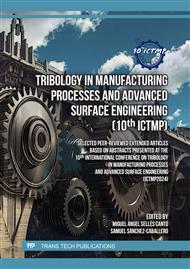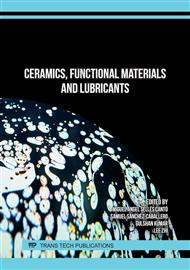[1]
Ma J, Fan B, Gao Y, et al., Effects of Kevlar® 29 yarn twist on tensile and tribological properties of self-lubricating fabric liner, Journal of Industrial Textiles, 46 (2017) 1698-1714.
DOI: 10.1177/1528083716631327
Google Scholar
[2]
Panda J N, Bijwe J, Pandey R K, Optimization of the amount of short glass fibers for superior wear performance of PAEK composites, Composites Part A: Applied Science and Manufacturing, 116 (2019) 158-168.
DOI: 10.1016/j.compositesa.2018.10.034
Google Scholar
[3]
Shivamurthy B, Murthy K, Anandhan S, Tribology and Mechanical Properties of Carbon Fabric/MWCNT/Epoxy Composites, Advances in Tribology, 2018 (2018) e1508145.
DOI: 10.1155/2018/1508145
Google Scholar
[4]
Ahmadijokani F, Shojaei A, Dordanihaghighi S, et al., Effects of hybrid carbon-aramid fiber on performance of non-asbestos organic brake friction composites, Wear, 452-453 (2020) 203280.
DOI: 10.1016/j.wear.2020.203280
Google Scholar
[5]
Kumar S, Singh K K, Ramkumar J, Comparative study of the influence of graphene nanoplatelets filler on the mechanical and tribological behavior of glass fabric-reinforced epoxy composites, Polymer Composites, 41 (2020) 5403-5417.
DOI: 10.1002/pc.25804
Google Scholar
[6]
He Y, Zhang Z, Wang Y, et al., Combined effect of interfacial modification and α-ZrP reinforcement on the tribological properties of PPS fabric/phenolic composites, Colloids and Surfaces A: Physicochemical and Engineering Aspects, 648 (2022) 129118.
DOI: 10.1016/j.colsurfa.2022.129118
Google Scholar
[7]
Bandaru A K, Weaver P M, O' Higgins R M, Abrasive wear performance of hygrothermally aged glass/PTFE composites, Polymer Testing, 103 (2021) 107369.
DOI: 10.1016/j.polymertesting.2021.107369
Google Scholar
[8]
Khan M.J, Wani M.F, Gupta R, Tribological properties of glass fiber filled polytetrafluoroethylene sliding against stainless steel under dry and aqueous environments: enhanced tribological performance in sea water, Materials Research Express, 5 (2018) 055309.
DOI: 10.1088/2053-1591/aac46c
Google Scholar
[9]
Kumar S, Singh K K, Tribological Performances of Woven Carbon Fabric/Epoxy Composites Under Dry and Oil Lubrication Condition: An Experimental Investigation, Trends in Materials Engineering: Select Proceedings of ICFTMM 2018, (2019) 43-50.
DOI: 10.1007/978-981-13-9016-6_5
Google Scholar
[10]
Gu D, Duan C, Fan B, et al., Tribological properties of hybrid PTFE/Kevlar fabric composite in vacuum, Tribology International, 103 (2016) 423-431.
DOI: 10.1016/j.triboint.2016.08.004
Google Scholar
[11]
Qiu M, Yang Z, Lu J, et al., Influence of step load on tribological properties of self-lubricating radial spherical plain bearings with PTFE fabric liner, Tribology International, 113 (2017) 344-353.
DOI: 10.1016/j.triboint.2017.02.047
Google Scholar
[12]
Wang H, Qi X, Zhang W, et al., Tribological properties of PTFE/Kevlar fabric composites under heavy loading, Tribology International, 151 (2020) 106507.
DOI: 10.1016/j.triboint.2020.106507
Google Scholar
[13]
Wenbin L, Jianfeng H, Jie F, et al., Study on tribological properties as a function of operating conditions for carbon fabric wet clutch, Tribology International, 94 (2016) 428-436.
DOI: 10.1016/j.triboint.2015.10.015
Google Scholar
[14]
Qiu M, Tian K W, Zhang Y T, Effect of ambient temperature on the formation mechanism of PTFE liner transfer film of spherical plain bearings, Mechanics & Industry, 22 (2021) 11.
DOI: 10.1051/meca/2021007
Google Scholar
[15]
Madej J, Śliwka M, Analysis of Interference-Fit Joints, Applied Sciences, 11 (2021) 11428.
DOI: 10.3390/app112311428
Google Scholar
[16]
Bonisoli E, Marcuccio G, Venturini S, Interference fit estimation through stress-stiffening effect on dynamics, Mechanical Systems and Signal Processing, 160 (2021) 107919.
DOI: 10.1016/j.ymssp.2021.107919
Google Scholar
[17]
Chen G, Qu M, Modeling and analysis of fit clearance between rolling bearing outer ring and housing, Journal of Sound and Vibration, 438 (2019) 419-440.
DOI: 10.1016/j.jsv.2017.11.004
Google Scholar
[18]
Lewis R, Marshall M B, Dwyer-Joyce R S, Measurement of interface pressure in interference fits, Proceedings of the Institution of Mechanical Engineers, Part C: Journal of Mechanical Engineering Science, 219 (2005) 127-139.
DOI: 10.1243/095440605x8432
Google Scholar



